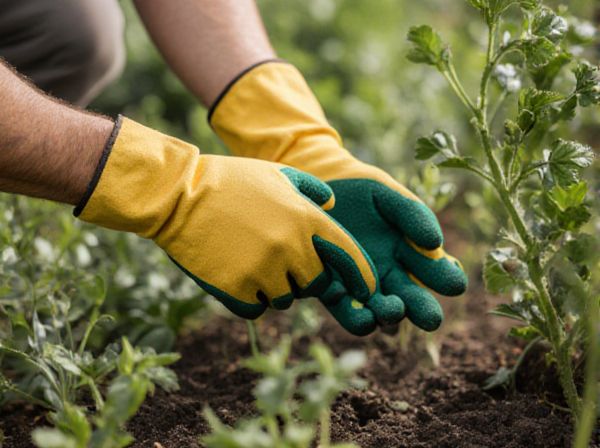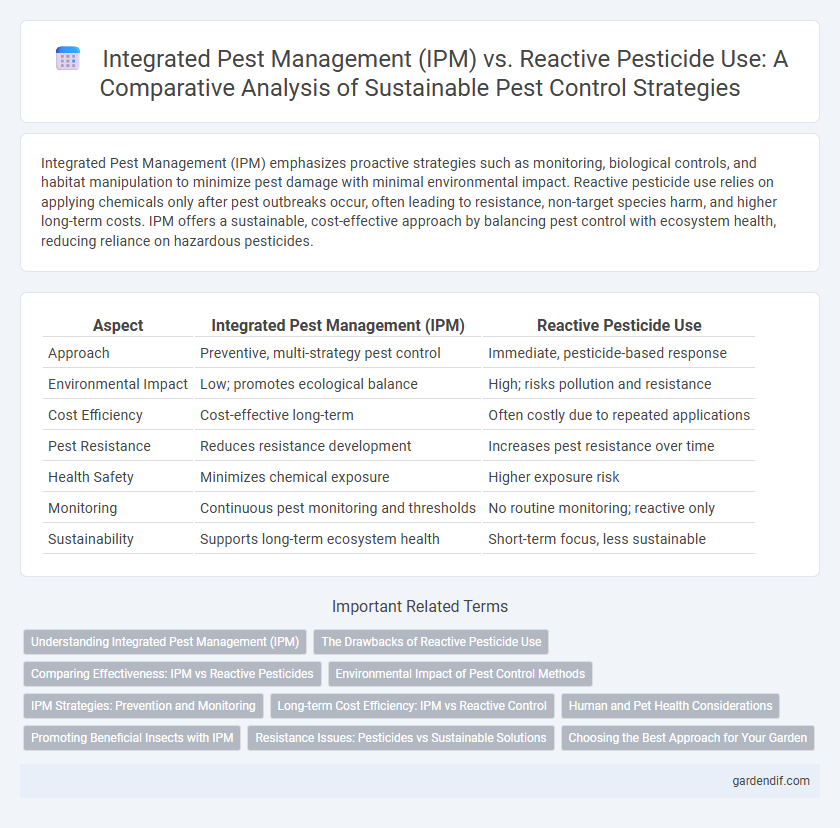
Integrated Pest Management (IPM) vs Reactive pesticide use Illustration
Integrated Pest Management (IPM) emphasizes proactive strategies such as monitoring, biological controls, and habitat manipulation to minimize pest damage with minimal environmental impact. Reactive pesticide use relies on applying chemicals only after pest outbreaks occur, often leading to resistance, non-target species harm, and higher long-term costs. IPM offers a sustainable, cost-effective approach by balancing pest control with ecosystem health, reducing reliance on hazardous pesticides.
Table of Comparison
| Aspect | Integrated Pest Management (IPM) | Reactive Pesticide Use |
|---|---|---|
| Approach | Preventive, multi-strategy pest control | Immediate, pesticide-based response |
| Environmental Impact | Low; promotes ecological balance | High; risks pollution and resistance |
| Cost Efficiency | Cost-effective long-term | Often costly due to repeated applications |
| Pest Resistance | Reduces resistance development | Increases pest resistance over time |
| Health Safety | Minimizes chemical exposure | Higher exposure risk |
| Monitoring | Continuous pest monitoring and thresholds | No routine monitoring; reactive only |
| Sustainability | Supports long-term ecosystem health | Short-term focus, less sustainable |
Understanding Integrated Pest Management (IPM)
Integrated Pest Management (IPM) is a sustainable approach to pest control that combines biological, cultural, mechanical, and chemical methods to minimize pest damage while reducing environmental impact. Emphasizing pest monitoring and identification, IPM uses targeted interventions only when pest levels exceed economic thresholds, preventing unnecessary pesticide applications. This strategy promotes long-term pest suppression, enhances crop health, and decreases pesticide resistance compared to reactive pesticide use.
The Drawbacks of Reactive Pesticide Use
Reactive pesticide use often leads to pesticide resistance, making pests harder to control over time and increasing costs for farmers. It can disrupt natural predator populations, leading to pest resurgence and secondary pest outbreaks. Frequent pesticide application also poses environmental and health risks, contaminating soil, water, and non-target species.
Comparing Effectiveness: IPM vs Reactive Pesticides
Integrated Pest Management (IPM) combines biological, cultural, mechanical, and chemical methods to sustainably control pest populations, reducing reliance on reactive pesticide use that often targets pests only after outbreaks occur. Studies demonstrate IPM's effectiveness through lower pest resistance development, minimized environmental impact, and enhanced crop yields compared to reactive pesticide application, which can lead to pesticide overuse and ecological imbalance. By emphasizing monitoring and prevention, IPM achieves long-term pest suppression while reactive pesticide approaches typically result in short-term pest control and increased risk of resurgence.
Environmental Impact of Pest Control Methods
Integrated Pest Management (IPM) significantly reduces environmental impact by combining biological, cultural, and mechanical control methods, minimizing reliance on chemical pesticides. Reactive pesticide use often leads to increased chemical application, resulting in harmful effects on non-target organisms, soil health, and water quality. IPM promotes sustainable agriculture by enhancing biodiversity and reducing pesticide residues in ecosystems.
IPM Strategies: Prevention and Monitoring
Integrated Pest Management (IPM) strategies emphasize prevention and monitoring to reduce pest populations sustainably, utilizing biological controls, habitat manipulation, and cultural practices to create unfavorable conditions for pests. Regular monitoring through traps and field inspections enables early detection, facilitating targeted interventions that minimize pesticide reliance and environmental impact. This proactive approach contrasts with reactive pesticide use, which often leads to resistance, non-target damage, and increased chemical inputs.
Long-term Cost Efficiency: IPM vs Reactive Control
Integrated Pest Management (IPM) offers long-term cost efficiency by combining biological, cultural, and mechanical control methods that reduce reliance on expensive chemical pesticides. Reactive pesticide use typically incurs higher costs over time due to repeated applications, pest resistance development, and potential crop damage. Investing in IPM strategies minimizes pest outbreaks and promotes sustainable pest control, ultimately lowering overall expenses for farmers and agricultural businesses.
Human and Pet Health Considerations
Integrated Pest Management (IPM) minimizes chemical exposure by emphasizing preventive measures, biological controls, and targeted treatments, significantly reducing risks to human and pet health. Reactive pesticide use often involves broad-spectrum chemicals that can cause acute poisoning, allergic reactions, and long-term health issues for families and animals. Prioritizing IPM strategies ensures safer environments by limiting toxic residues and promoting balanced ecosystems.
Promoting Beneficial Insects with IPM
Integrated Pest Management (IPM) emphasizes promoting beneficial insects to naturally control pest populations, reducing reliance on chemical pesticides. Encouraging predators and pollinators through habitat enhancement and selective pesticide use supports ecological balance and pest suppression. This sustainable approach minimizes environmental impact and enhances long-term crop health compared to reactive pesticide applications.
Resistance Issues: Pesticides vs Sustainable Solutions
Integrated Pest Management (IPM) employs sustainable solutions such as biological controls and crop rotation to minimize pest resistance, contrasting with reactive pesticide use that often accelerates resistance development. Reactive pesticide applications lead to repeated exposure, fostering pest populations that survive chemical treatments and propagate resistant genes. Sustainable IPM strategies reduce reliance on chemicals, preserving pesticide efficacy and promoting long-term agricultural productivity.
Choosing the Best Approach for Your Garden
Integrated Pest Management (IPM) offers a sustainable, environmentally friendly approach by combining biological controls, cultural practices, and minimal chemical use to reduce pest populations effectively. Reactive pesticide use, relying heavily on chemical applications after pest outbreaks, can lead to resistance, environmental harm, and disruption of beneficial insect populations. Choosing IPM supports long-term garden health, pest prevention, and reduces the risk of pesticide overuse, making it the best approach for maintaining a balanced and thriving garden ecosystem.
Integrated Pest Management (IPM) vs Reactive pesticide use Infographic

 gardendif.com
gardendif.com